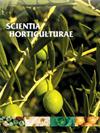不同发光二极管(LED)光质参数对辣椒(Capsicum annuum L.)成熟期和花朵发育的影响
IF 3.9
2区 农林科学
Q1 HORTICULTURE
引用次数: 0
摘要
辣椒(Capsicum annuum L.)需要较长的成熟期,这是降低其市场价值的一个关键因素。一项研究评估了红光(R)/蓝光(B)/白光(W)对缩短辣椒成熟期和改变其代谢物的影响。使用 4R:1B:5W 组产生了最佳光质参数,使红色果实的比例更高,种子发育更早,成熟期更短。其他研究表明,成熟期的缩短与从种子到开花的阶段密切相关,因为观察到所有组别都需要更多的天数来完成这一阶段。对辣椒花的转录组-代谢组的综合分析表明,4R:1B:5W 组的紫色花与类黄酮含量的增加有关,特别是牡荆素和青花素,它们受对香豆酰奎尼酸、紫杉叶素和槲皮素等多种代谢物的调节。总有机酸和酚类物质含量的增加,以及总氨基酸和碳水化合物含量的减少,也对 4R:1B:5W 组的花朵发育起着关键作用。这可能与光照质量诱导的植物激素密切相关。乙烯反应因子,特别是 ERF021,由于参与了所有相关的代谢途径,被确定为花发育过程中潜在的枢纽调节因子。这一发现将为提高辣椒的商业价值提供重要启示。本文章由计算机程序翻译,如有差异,请以英文原文为准。
Effect of different light emitting diode (LED) light quality parameters on the maturation period and development of flowers in hot pepper (Capsicum annuum L.)
The need for a lengthy maturation period is a key factor that reduces the market value of hot peppers (Capsicum annuum L.). A study was performed to assess the effects of the red (R)/blue (B)/white (W) qualities of light at reducing the period of maturation and changes in the metabolites of hot peppers. The use of the 4R:1B:5W group produced the optimal parameter of light qualities, which resulted in a higher percentage of red fruits, earlier seed development and a shorter maturation period. Additional research showed that the reduction in the period of maturation is closely related to the stage from seed to flowering owing to observation of the need for more days to complete the stage in all the groups. A combined analysis of the transcriptome-metabolome in the hot pepper flowers showed that the purple flowers in the 4R:1B:5W group were associated with an increase in the contents of flavonoids, particularly vitexin and cyanin, which are regulated by various metabolites, such as p-coumaroyl quinic acid, taxifolin, and quercetin among others. Increased levels of the total organic acids and phenolics, as shown by the decrease in the contents of total amino acids and carbohydrates also play a key role in the development of flowers in the 4R:1B:5W group. This may be closely related to the plant hormones induced by the quality of light. Ethylene responsive factors, particularly ERF021, were identified as potential hub regulators during the development of flowers owing to their involvement in all the associated metabolic pathways. This finding will provide key insights to improve the commercial value of hot peppers.
求助全文
通过发布文献求助,成功后即可免费获取论文全文。
去求助
来源期刊

Scientia Horticulturae
农林科学-园艺
CiteScore
8.60
自引率
4.70%
发文量
796
审稿时长
47 days
期刊介绍:
Scientia Horticulturae is an international journal publishing research related to horticultural crops. Articles in the journal deal with open or protected production of vegetables, fruits, edible fungi and ornamentals under temperate, subtropical and tropical conditions. Papers in related areas (biochemistry, micropropagation, soil science, plant breeding, plant physiology, phytopathology, etc.) are considered, if they contain information of direct significance to horticulture. Papers on the technical aspects of horticulture (engineering, crop processing, storage, transport etc.) are accepted for publication only if they relate directly to the living product. In the case of plantation crops, those yielding a product that may be used fresh (e.g. tropical vegetables, citrus, bananas, and other fruits) will be considered, while those papers describing the processing of the product (e.g. rubber, tobacco, and quinine) will not. The scope of the journal includes all horticultural crops but does not include speciality crops such as, medicinal crops or forestry crops, such as bamboo. Basic molecular studies without any direct application in horticulture will not be considered for this journal.
 求助内容:
求助内容: 应助结果提醒方式:
应助结果提醒方式:


